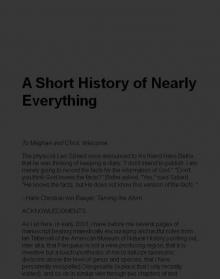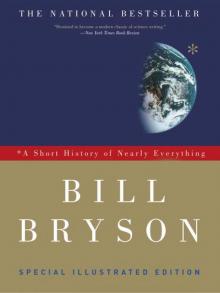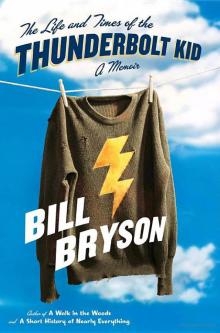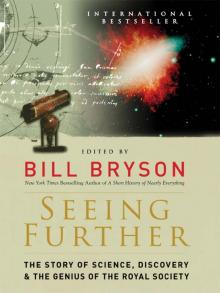- Home
- Bill Bryson
A Short History of Nearly Everything: Special Illustrated Edition Page 2
A Short History of Nearly Everything: Special Illustrated Edition Read online
Page 2
So I decided that I would devote a portion of my life—three years, as it now turns out—to reading books and journals and finding saintly, patient experts prepared to answer a lot of outstandingly dumb questions. The idea was to see if it isn’t possible to understand and appreciate—marvel at, enjoy even—the wonder and accomplishments of science at a level that isn’t too technical or demanding, but isn’t entirely superficial either.
That was my idea and my hope, and that is what the book that follows is intended to do. Anyway, we have a great deal of ground to cover and much less than 650,000 hours in which to do it, so let’s begin.
(credit i.2)
The Milky Way, our home galaxy, looks almost cosy in an artist’s rendering, but, at 100,000 light years across, it is of a scale that we struggle to imagine. The fastest spaceship yet built would take 25,000 years to reach our nearest star (less than a millimetre away on the scale of the illustration) and far longer than humans have existed as a species to find its way to the galactic centre. Scientists are unsure how many stars there are in the galaxy. It may be 100 billion; it may be 400 billion. (credit p1.1)
HOW TO BUILD A UNIVERSE
No matter how hard you try you will never be able to grasp just how tiny, how spatially unassuming, is a proton. It is just way too small.
A proton is an infinitesimal part of an atom, which is itself of course an insubstantial thing. Protons are so small that a little dib of ink like the dot on this “i” can hold something in the region of 500,000,000,000 of them, or rather more than the number of seconds it takes to make half a million years. So protons are exceedingly microscopic, to say the very least.
Now imagine if you can (and of course you can’t) shrinking one of those protons down to a billionth of its normal size into a space so small that it would make a proton look enormous. Now pack into that tiny, tiny space about an ounce of matter. Excellent. You are ready to start a universe.
I’m assuming of course that you wish to build an inflationary universe. If you’d prefer instead to build a more old-fashioned, standard Big Bang universe, you’ll need additional materials. In fact, you will need to gather up everything there is—every last mote and particle of matter between here and the edge of creation—and squeeze it into a spot so infinitesimally compact that it has no dimensions at all. It is known as a singularity.
In either case, get ready for a really big bang. Naturally, you will wish to retire to a safe place to observe the spectacle. Unfortunately, there is nowhere to retire to because outside the singularity there is no where. When the universe begins to expand, it won’t be spreading out to fill a larger emptiness. The only space that exists is the space it creates as it goes.
It is natural but wrong to visualize the singularity as a kind of pregnant dot hanging in a dark, boundless void. But there is no space, no darkness. The singularity has no around around it. There is no space for it to occupy, no place for it to be. We can’t even ask how long it has been there—whether it has just lately popped into being, like a good idea, or whether it has been there for ever, quietly awaiting the right moment. Time doesn’t exist. There is no past for it to emerge from.
And so, from nothing, our universe begins.
In a single blinding pulse, a moment of glory much too swift and expansive for any form of words, the singularity assumes heavenly dimensions, space beyond conception. The first lively second (a second that many cosmologists will devote careers to shaving into ever-finer wafers) produces gravity and the other forces that govern physics. In less than a minute the universe is a million billion miles across and growing fast. There is a lot of heat now, ten billion degrees of it, enough to begin the nuclear reactions that create the lighter elements—principally hydrogen and helium, with a dash (about one atom in a hundred million) of lithium. In three minutes, 98 per cent of all the matter there is or will ever be has been produced. We have a universe. It is a place of the most wondrous and gratifying possibility, and beautiful, too. And it was all done in about the time it takes to make a sandwich.
When this moment happened is a matter of some debate. Cosmologists have long argued over whether the moment of creation was ten billion years ago or twice that or something in between. The consensus seems to be heading for a figure of about 13.7 billion years, but these things are notoriously difficult to measure, as we shall see further on. All that can really be said is that at some indeterminate point in the very distant past, for reasons unknown, there came the moment known to science as t = 0. We were on our way.
There is of course a great deal we don’t know, and much of what we think we know we haven’t known, or thought we’ve known, for long. Even the notion of the Big Bang is quite a recent one. The idea had been kicking around since the 1920s when Georges Lemaître, a Belgian priest-scholar, first tentatively proposed it, but it didn’t really become an active notion in cosmology until the mid-1960s, when two young radio astronomers made an extraordinary and inadvertent discovery.
Their names were Arno Penzias and Robert Wilson. In 1965, they were trying to make use of a large communications antenna owned by Bell Laboratories at Holmdel, New Jersey, but they were troubled by a persistent background noise—a steady, steamy hiss that made any experimental work impossible. The noise was unrelenting and unfocused. It came from every point in the sky, day and night, through every season. For a year the young astronomers did everything they could think of to track down and eliminate the noise. They tested every electrical system. They rebuilt instruments, checked circuits, wiggled wires, dusted plugs. They climbed into the dish and placed duct tape over every seam and rivet. They climbed back into the dish with brooms and scrubbing brushes and carefully swept it clean of what they referred to in a later paper as “white dielectric material,” or what is known more commonly as bird shit. Nothing they tried worked.
Unknown to them, just 50 kilometres away at Princeton University a team of scientists led by Robert Dicke was working on how to find the very thing they were trying so diligently to get rid of. The Princeton researchers were pursuing an idea that had been suggested in the 1940s by the Russian-born astrophysicist George Gamow: that if you looked deep enough into space you should find some cosmic background radiation left over from the Big Bang. Gamow calculated that by the time it had crossed the vastness of the cosmos the radiation would reach Earth in the form of microwaves. In a more recent paper he had even suggested an instrument that might do the job: the Bell antenna at Holmdel. Unfortunately, neither Penzias and Wilson, nor any of the Princeton team, had read Gamow’s paper.
The noise that Penzias and Wilson were hearing was, of course, the noise that Gamow had postulated. They had found the edge of the universe, or at least the visible part of it, 90 billion trillion miles away. They were “seeing” the first photons—the most ancient light in the universe—though time and distance had converted them to microwaves, just as Gamow had predicted. In his book The Inflationary Universe, Alan Guth provides an analogy that helps to put this finding in perspective. If you think of peering into the depths of the universe as like looking down from the hundredth floor of the Empire State Building (with the hundredth floor representing now and street level representing the moment of the Big Bang), at the time of Wilson and Penzias’s discovery the most distant galaxies anyone had ever detected were on about the sixtieth floor and the most distant things—quasars—were on about the twentieth. Penzias and Wilson’s finding pushed our acquaintance with the visible universe to within half an inch of the lobby floor.
American astrophysicists Arno Penzias and Robert Wilson at the communications dish in New Jersey where they discovered—quite by accident—cosmic background radiation, the most distant relic of the birth of the universe. The discovery won them the 1978 Nobel Prize for Physics. (credit 1.1)
Still unaware of what caused the noise, Wilson and Penzias phoned Dicke at Princeton and described their problem to him in the hope that he might suggest a solution. Dicke realized at once what the two young men had f
ound. “Well, boys, we’ve just been scooped,” he told his colleagues as he hung up the phone.
Soon afterwards the Astrophysical Journal published two articles: one by Penzias and Wilson describing their experience with the hiss, the other by Dicke’s team explaining its nature. Although Penzias and Wilson had not been looking for cosmic background radiation, didn’t know what it was when they had found it, and hadn’t described or interpreted its character in any paper, they received the 1978 Nobel Prize in Physics. The Princeton researchers got only sympathy. According to Dennis Overbye in Lonely Hearts of the Cosmos, neither Penzias nor Wilson altogether understood the significance of what they had found until they read about it in the New York Times.
But of course the universe had no size at all before the Big Bang. (credit 1.3)
Incidentally, disturbance from cosmic background radiation is something we have all experienced. Tune your television to any channel it doesn’t receive and about 1 per cent of the dancing static you see is accounted for by this ancient remnant of the Big Bang. The next time you complain that there is nothing on, remember that you can always watch the birth of the universe.
Neither Penzias nor Wilson altogether understood the significance of what they had found until they read about it in the New York Times
A coloured temperature image of the first photons ever created, representing the most ancient light in the universe, which are detectable on Earth as a faint, steady background noise or—more familiarly to most of us—as part of the static on TV pictures. (credit 1.2)
Although everyone calls it the Big Bang, many books caution us not to think of it as an explosion in the conventional sense. It was, rather, a vast, sudden expansion on a whopping scale. So what caused it?
One notion is that perhaps the singularity was the relic of an earlier, collapsed universe—that ours is just one of an eternal cycle of expanding and collapsing universes, like the bladder on an oxygen machine. Others attribute the Big Bang to what they call “a false vacuum” or “a scalar field” or “vacuum energy”—some quality or thing, at any rate, that introduced a measure of instability into the nothingness that was. It seems impossible that you could get something from nothing, but the fact that once there was nothing and now there is a universe is evident proof that you can. It may be that our universe is merely part of many larger universes, some in different dimensions, and that Big Bangs are going on all the time all over the place. Or it may be that space and time had some other forms altogether before the Big Bang—forms too alien for us to imagine—and that the Big Bang represents some sort of transition phase, where the universe went from a form we can’t understand to one we almost can. “These are very close to religious questions,” Dr. Andrei Linde, a cosmologist at Stanford, told the New York Times in 2001.
The Big Bang theory isn’t about the bang itself but about what happened after the bang. Not long after, mind you. By doing a lot of maths and watching carefully what goes on in particle accelerators, scientists believe they can look back to 10−43 seconds after the moment of creation, when the universe was still so small that you would have needed a microscope to find it. We mustn’t swoon over every extraordinary number that comes before us, but it is perhaps worth latching onto one from time to time just to be reminded of their ungraspable and amazing breadth. Thus 10−43 is 0.0000000000000000000000000000000000000000001, or one ten million trillion trillion trillionths of a second.1
Most of what we know, or believe we know, about the early moments of the universe is thanks to an idea called inflation theory first propounded in 1979 by a junior particle physicist then at Stanford, now at MIT, named Alan Guth. He was thirty-two years old and, by his own admission, had never done anything much before. He would probably never have had his great theory except that he happened to attend a lecture on the Big Bang given by none other than Robert Dicke. The lecture inspired Guth to take an interest in cosmology, and in particular in the birth of the universe.
The eventual result was the inflation theory, which holds that a fraction of a moment after the dawn of creation, the universe underwent a sudden dramatic expansion. It inflated—in effect ran away with itself, doubling in size every 10−34 seconds. The whole episode may have lasted no more than 10−30 seconds—that’s one million million million million millionths of a second—but it changed the universe from something you could hold in your hand to something at least 10,000,000,000,000,000,000,000,000 times bigger. Inflation theory explains the ripples and eddies that make our universe possible. Without it, there would be no clumps of matter and thus no stars, just drifting gas and everlasting darkness.
According to Guth’s theory, at one ten-millionth of a trillionth of a trillionth of a trillionth of a second, gravity emerged. After another ludicrously brief interval it was joined by electromagnetism and the strong and weak nuclear forces—the stuff of physics. These were joined an instant later by shoals of elementary particles—the stuff of stuff. From nothing at all, suddenly there were swarms of photons, protons, electrons, neutrons and much else—between 1079 and 1089 of each, according to the standard Big Bang theory.
Such quantities are of course ungraspable. It is enough to know that in a single cracking instant we were endowed with a universe that was vast—at least a hundred billion light years across, according to the theory, but possibly any size up to infinite—and perfectly arrayed for the creation of stars, galaxies and other complex systems.
What is extraordinary from our point of view is how well it turned out for us. If the universe had formed just a tiny bit differently—if gravity were fractionally stronger or weaker, if the expansion had proceeded just a little more slowly or swiftly—then there might never have been stable elements to make you and me and the ground we stand on. Had gravity been a trifle stronger, the universe itself might have collapsed like a badly erected tent without precisely the right values to give it the necessary dimensions and density and component parts. Had it been weaker, however, nothing would have coalesced. The universe would have remained forever a dull, scattered void.
This is one reason why some experts believe that there may have been many other big bangs, perhaps trillions and trillions of them, spread through the mighty span of eternity, and that the reason we exist in this particular one is that this is one that we could exist in. As Edward P. Tryon of Columbia University once put it: “In answer to the question of why it happened, I offer the modest proposal that our Universe is simply one of those things which happen from time to time.” To which adds Guth: “Although the creation of a universe might be very unlikely, Tryon emphasized that no one had counted the failed attempts.”
In its first three minutes, according to inflation theory, the universe ran away with itself, doubling in size every one million million million million millionths of a second. Ninety-eight per cent of all that exists was created in those first 180 seconds. (credit 1.4)
Martin Rees, Britain’s Astronomer Royal, believes that there are many universes, possibly an infinite number, each with different attributes, in different combinations, and that we simply live in one that combines things in the way that allows us to exist. He makes an analogy with a very large clothing store: “If there is a large stock of clothing, you’re not surprised to find a suit that fits. If there are many universes, each governed by a differing set of numbers, there will be one where there is a particular set of numbers suitable to life. We are in that one.”
For the universe to exist as it does requires that hydrogen be converted to helium in a precise but comparatively stately manner. Tweak the numbers even slightly and we would not be here.
Optical image of the Eagle Nebula, a vast but youthful cloud of interstellar gas some 7,500 light years from Earth in a neighbouring arm of the Milky Way. Here new stars are being formed in towering columns of condensing gas, billions of kilometres long. This stellar swarm, as it is known, is a relative infant—only about 5.5 million years old. (credit 1.5)
Rees maintains that six numbers in part
icular govern our universe, and that if any of these values were changed even very slightly things could not be as they are. For example, for the universe to exist as it does requires that hydrogen be converted to helium in a precise but comparatively stately manner—specifically, in a way that converts seven one-thousandths of its mass to energy. Lower that value very slightly—from 0.007 per cent to 0.006 per cent, say—and no transformation could take place: the universe would consist of hydrogen and nothing else. Raise the value very slightly—to 0.008 per cent—and bonding would be so wildly prolific that the hydrogen would long since have been exhausted. In either case, with the slightest tweaking of the numbers the universe as we know and need it would not be here.
I should say that everything is just right so far. In the long term, gravity may turn out to be a little too strong; one day it may halt the expansion of the universe and bring it collapsing in upon itself, until it crushes itself down into another singularity, possibly to start the whole process over again. On the other hand, it may be too weak, in which case the universe will keep racing away for ever until everything is so far apart that there is no chance of material interactions, so that the universe becomes a place that is very roomy, but inert and dead. The third option is that gravity is perfectly pitched—“critical density” is the cosmologists’ term for it—and that it will hold the universe together at just the right dimensions to allow things to go on indefinitely. Cosmologists, in their lighter moments, sometimes call this the “Goldilocks effect”—that everything is just right. (For the record, these three possible universes are known respectively as closed, open and flat.)

 Notes from a Small Island
Notes from a Small Island A Short History of Nearly Everything
A Short History of Nearly Everything A Walk in the Woods
A Walk in the Woods I'm a Stranger Here Myself
I'm a Stranger Here Myself The Mother Tongue
The Mother Tongue Shakespeare
Shakespeare A Short History of Nearly Everything: Special Illustrated Edition
A Short History of Nearly Everything: Special Illustrated Edition The Best American Travel Writing 2016
The Best American Travel Writing 2016 The Road to Little Dribbling
The Road to Little Dribbling The Life And Times Of The Thunderbolt Kid: A Memoir (v5.0)
The Life And Times Of The Thunderbolt Kid: A Memoir (v5.0) Made In America
Made In America Seeing Further
Seeing Further Shakespeare: The World as Stage
Shakespeare: The World as Stage The Life and Times of the Thunderbolt Kid
The Life and Times of the Thunderbolt Kid At Home
At Home Bryson's Dictionary For Writers And Editors (v5.0)
Bryson's Dictionary For Writers And Editors (v5.0) Neither Here Nor There
Neither Here Nor There Bill Bryson's African Diary
Bill Bryson's African Diary